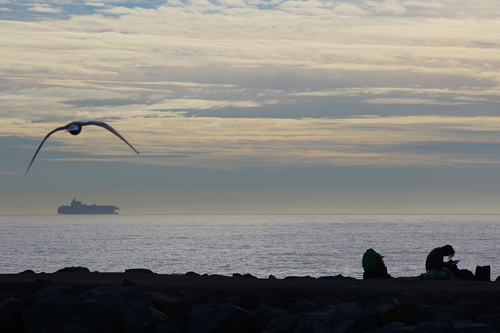 Photo: Roman Harald/flickr.com/CC BY-NC-ND
Photo: Roman Harald/flickr.com/CC BY-NC-ND
Member states must carry out inspections on at least one-tenth of the ships calling each year, and test the fuel on at least 20–40 per cent of the inspected ships.
A new set of rules that require member states to check compliance with the EU’s ship fuel sulphur regulation was agreed in December 2014 and published in February.
The new rules can be seen as a first response to increasing criticism about the lax regimes currently in place to ensure enforcement of environmental standards for international shipping, and is directly linked to the recent entry into force of the 0.10 per cent sulphur limit on marine fuels used within emission control areas (ECAs) as from 1 January 2015.
For Europe, the stricter sulphur standards mean that ships in the North Sea and Baltic Sea must use low-sulphur fuels or apply approved abatement technology to achieve equivalent emission reductions.
Rules concerning inspections, sampling methods and frequency, as well as reporting, are laid down in a Commission Implementing Decision, which states that sampling of marine fuel on board ships should be carried out either by analysing a fuel spot sample from the ship’s fuel service system, or by analysing the relevant sealed bunker samples on board.
When it comes to sampling of marine fuels while being delivered to ships, this should target marine fuel suppliers who have been repeatedly found not to comply with the specification stated on the bunker delivery note.
Member states must carry out inspections of ships’ logbooks and bunker delivery notes (BDN) on at least 10 per cent of the total number of individual ships calling in the relevant member state each year.
From 1 January 2016, member states must also carry out sulphur tests on the marine fuel being used on board on a certain percentage of ships calling at their ports. This varies from 40 per cent (of the minimum 10 per cent ships that are to be inspected) for countries fully bordering ECAs, to 30 per cent for those partly bordering ECAs, and down to 20 per cent for countries not bordering ECAs.
Establishing minimum inspection, sampling and reporting requirements is however only a first step – in order to ensure compliance there must also be penalties in place for non-compliance, but this issue is not part of the new inspection and reporting rules.
According to the EU sulphur directive, it is up to the member states to determine the penalties. It is stated that: “The penalties determined must be effective, proportionate and dissuasive and may include fines calculated in such a way as to ensure that the fines at least deprive those responsible of the economic benefits derived from their infringement and that those fines gradually increase for repeated infringements.”
Over the past few years, there have been discussions in member states such as Denmark, Netherlands, Sweden and Finland on the need to introduce such penalties, and to ensure a workable and effective legal system to implement the sanctions.
However, it still appears uncertain how many – if any – member states have such “effective, proportionate and dissuasive” penalties in place. It is also not clear how many member states – if any – have a legal system in place that ensures that those found to be in breach of the standards will actually be made to pay the penalties.
Christer Ågren
Source: “Commission Implementing Decision (EU) 2015/253 of 16 February 2015 laying down the rules concerning the sampling and reporting under Council Directive 1999/32/EC as regards the sulphur content of marine fuels.” Official Journal of the European Union L041.















